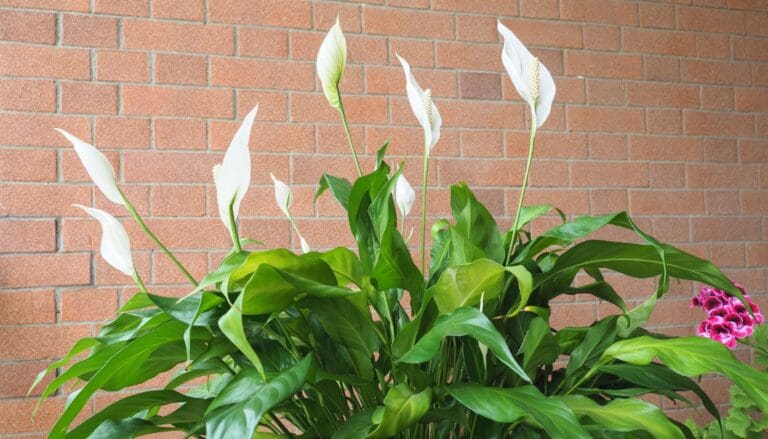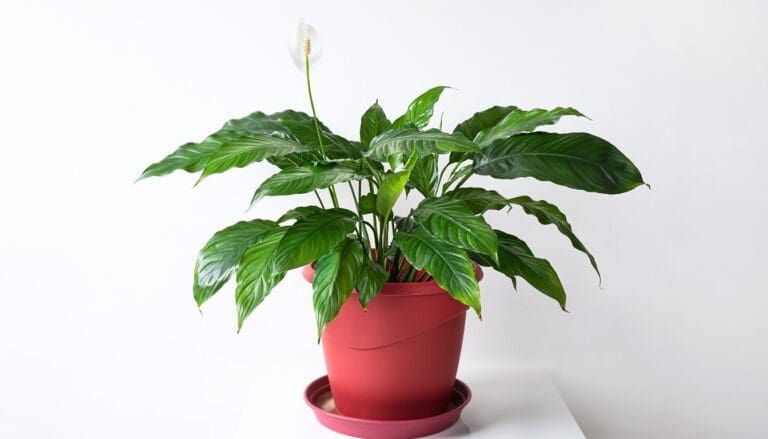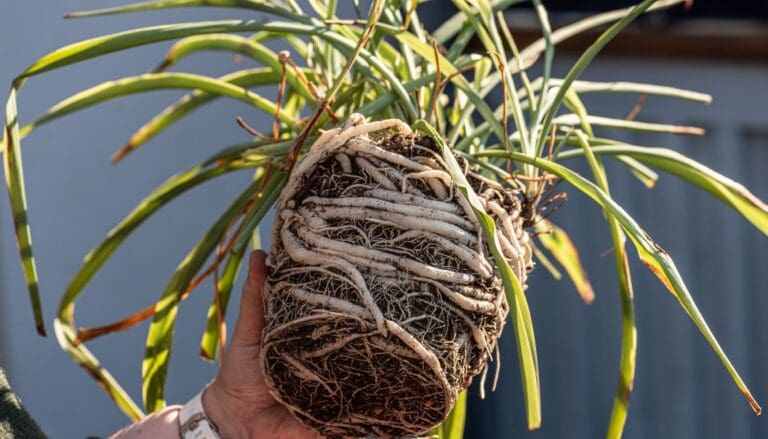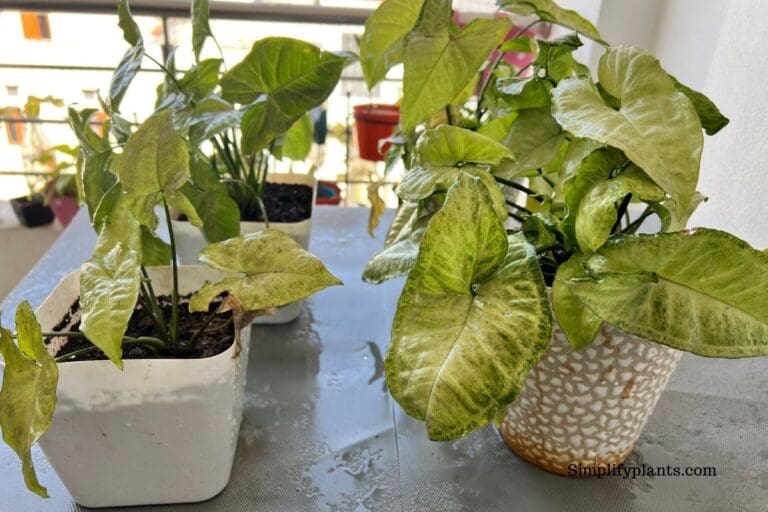Schefflera Care In Winter: Light, Watering,& More
Plant owners love Schefflera for its evergreen foliage. But since it is a tropical plant, its winter survival and care are big concerns for the owners. I am here to answer that for you.
Schefflera plants can survive winter with proper care and maintenance. But they can’t tolerate extreme cold, so you need to protect them from frost. You must reduce watering, stop fertilizing the Schefflera during winter, and maintain optimum temperatures and humidity.
In this article, I will discuss the problems your Schefflera might face in winter and how you can take care of it to help it survive this season. Keep reading to learn everything.
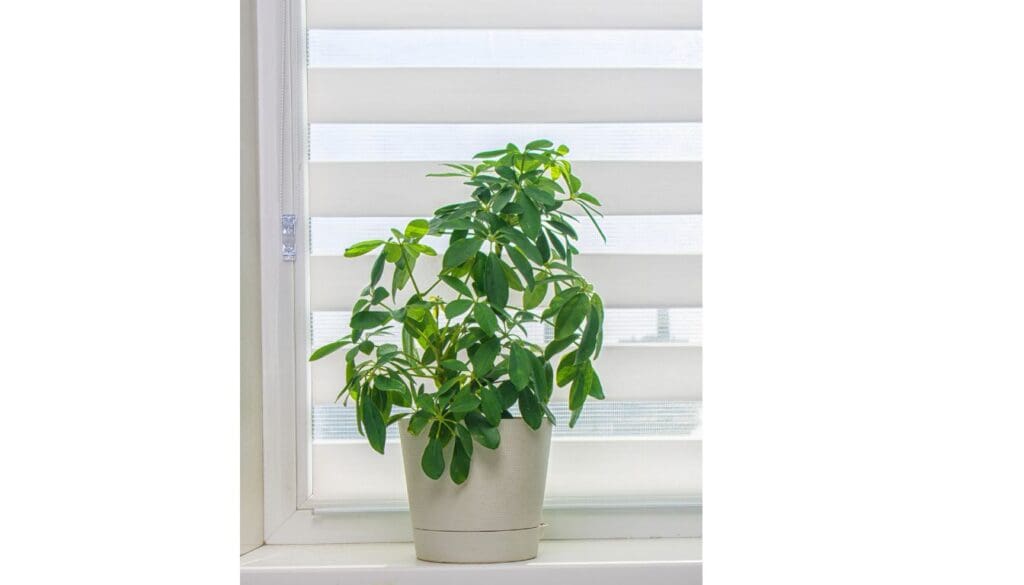
Please note: Simplify Plants is reader-supported. Some links in the post are affiliate links and I get a commission from purchases made through links in the post.
Can Schefflera plants survive winters?
Schefflera plants can survive winters if they get the right care.
The ideal temperature is between 65-85°F, but it can tolerate anything between 35-105°F.
However, in areas of extreme cold, the temperatures may go lower than what the plant can tolerate, and in that case, it will require support.
Therefore you must understand the right way to care for the Schefflera plant in the cold conditions because, in such weather, your plant will need specific care.
Common problems of Schefflera plants in winters
Being native to the tropical world, this plant suffers certain problems when the temperature goes low.
If the temperatures go below 35-40°F, your plant will start showing symptoms. Let us discuss some of them.
Wilting
Wilting leaves are a major problem in winter as the plant begins to droop due to dry air that sucks the moisture out of the plant, low temperature, incorrect watering, etc.
Overwatering
Overwatering is a serious problem in winter.
Due to low light, the evaporation rates drop, so the moisture persists for a longer period.
Overwatering can lead to multiple issues like yellowing leaves, droopy leaves, mushy stems, etc.
Due to low light intensity, the soil stays moist for a longer time.
If not taken care of, this can lead to overwatering and root rot problems, ultimately killing your Schefflera.
Stunted growth

Warmth-loving plants like Schefflera, native to tropical regions, cease to push out new grown in winter.
During winter, these plants go into dormancy due to unfavorable circumstances like low light, dry air, low humidity, etc.
Many plant owners get worried about their plants not growing in winters, but you need not worry.
With the advancement of the spring, as the climate begins to get warmer and days longer, the umbrella plant starts to grow rapidly.
Overfertilization
A mistake plant growers make is that sometimes they fertilize their plants in winter, thinking it will help them grow.
Due to the slow growth in winters, the plants do not have much activity.
Adding fertilizer to the plant in winter does not let the plant use the food which stays in the soil resulting in root burn.
Fertilize the plant once the warmer season approaches and the plant picks up the growth again.
Pest infestations
Schefflera might be prone to pest attacks during winter due to the low intensity and duration of sunlight, cold temperature, and dry air.
If you don’t provide the right care, the plant remains dormant and becomes more susceptible to pest infestations.
Aphids, mealybugs, thrips, and scales are some of the nastiest bugs that attack the Schefflera in such conditions.
How do you take care of your Schefflera in winter?
Since Schefflera or umbrella plants belong to tropical regions, they love warmth and moisture.
Winter is not the ideal season for this plant, due to which it is important to provide a suitable condition so it can survive the cold.
1. Provide sufficient light

Light is the most basic need for plants which helps them photosynthesize and prepare food for survival and growth.
One of the primary problems of the winter season that makes the plants stagnant during the season is the low sunlight.
The intensity and duration of sunlight that the plant receives reduce.
Due to this, the plant produces less food, which reduces its ability to photosynthesize and pushes it into dormancy.
Now let us discuss a few tips to deal with this.
- Keep your Schefflera at a place where it can get a few hours of mild morning sunlight. Since the morning sunlight is mild, it helps the plant get some warmth.
- Make sure you keep your plant away from frosty windows.
- You can keep the Schefflera at a bright spot that receives indirect sunlight during the morning, such as the south-facing balcony or window.
- Make sure the leaves of the umbrella plant are clean to absorb as much light as it gets.
- Keep rotating the plant every week so that all the sides grow evenly and do not become leggy searching for light.
- If you think your house does not have enough natural light, you can install artificial lights.
Also read: What Kind Of Light Does A Schefflera Need?
2. Reduce watering
One vital point plant growers must remember is that the watering schedule changes with time.
You cannot continue watering your Schefflera the same way in winters as you do in summers.
Schefflera plants can tolerate being underwatered but are sensitive to overwatering.
During winters with low light intensity and a slower growth rate, the plant uses lesser water than it does in the growing season.
The soil stays wet for a longer time, so you must reduce the watering during winters to prevent overwatering and root rot.
During winters, you must check the soil before watering to check the soil’s moisture level.
Dip your finger into the soil to check if it sticks to your finger, or use a moisture meter to check the soil’s moisture.
Do not forget to empty the cache or trays that collect the excess water.
Refrain from using too cold or too warm water, which can further stress the plant.
Use room temperature distilled water for your Schefflera.
Also read: How Much Water Does A Schefflera Plant Need? (Watering Guide)
3. Provide enough humidity
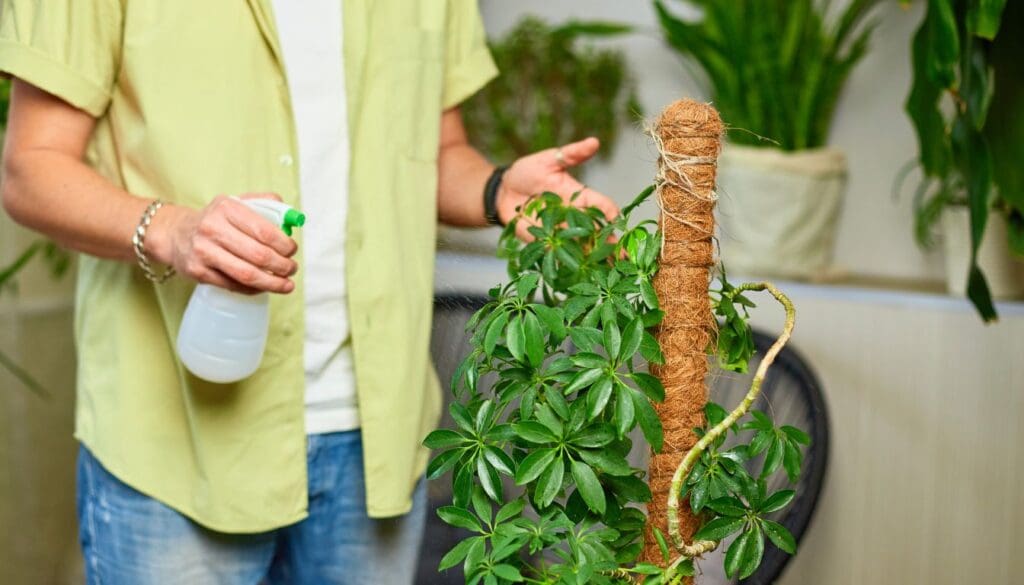
Another common problem is that the plants droop and shed leaves due to dry air during winters.
The humidity level reduces drastically, which is unsuitable for moisture-loving plants like Schefflera.
Low humidity can lead to brown or yellow dehydrated and wrinkly leaves and make the plant look droopy.
Schefflera plant requires humidity of at least around 60%.
To prevent low humidity problems, here are a few solutions.
- Use a humidifier: Installing a humidifier is an easy and long-lasting way to increase the humidity around plants. You have to fill the humidifier with distilled water and place it near the plants. It helps to maintain the correct humidity range for your plant.
- Pebble tray: Pebble trays are another easy and simple way to increase the humidity around the plants. Take a tray, fill it with a layer of pebbles, and fill it with water. Place the pot on the pebbles. As the water from the tray evaporates, the humidity around the plant will increase.
- Grouping: Grouping your tropical moisture-loving plants helps them replicate their natural surroundings, increasing the humidity around the plants.
- Misting: Misting is another option to increase the humidity of plants, but it gives short-term results only.
- If you have an aquarium, you can keep the plant near it. The evaporated water from the aquarium will increase the humidity around the plant.
- Humid areas in the home: You can shift your Schefflera plant to naturally humid rooms like the kitchen, laundry room, and bathroom, provided these areas have light and good airflow.
Also read: Should I Mist My Schefflera? (+Humidity Requirement Guide)
4. Maintain the temperature
Severe low temperatures can harm your plant.
The ideal temperature range for Schefflera is 60-75°F.
It is crucial to protect the plant in areas that face extreme cold.
Do not leave your plant outdoors if you live in an area that gets frost in winter.
The plant needs warmth to survive.
Frost can immediately kill your tropical-loving Schefflera.
Let us discuss a few solutions to keep the plant warm in the harsh cold.
- Bring your Schefflera plant inside in winter to keep it warm.
- Many people keep the plant near heaters or fireplaces to give it warmth but do not do that. It only sucks out the moisture from the plant more.
- You can keep the plant in a room with a fireplace or heater but make sure it is a few feet away from the source.
- Do not keep the plant near frosted windows or balconies.
- Do not keep the plant where the leaves get rubbed against glass panes.
- The places with temperature fluctuations like cold draft, near doors, and windows are unsuitable for your plant.
Also read: Can Schefflera Get Too Much Sun? (Sunburn)
5. Examine the plant for pests

The chances of pest and bug attacks can go up in the winter due to low light and overwatering.
Mealybugs, thrips, spider mites, and scales are some of the bugs that disturb this plant very often.
If you keep the soil constantly moist and soggy, the pests will attack the plant more, and fungus will breed in the soil because low light evaporation rates are lower.
Therefore, it is important to let the soil dry out between watering in winters and keep the plant in an area with ample light and water.
Also, it is recommended to spray Neem oil often to keep the plant free of pests and bugs.
Also read: Schefflera Pest Problems: Common Pests & Diseases+How To Fix
6. Do not fertilize the Schefflera in winter
A major mistake many plant owners do is feeding their plants in winter.
Experts suggest you must never fertilize the Schefflera in winters because the plant has low energy during this time.
So fertilizing does not let the plant use up the nutrients and stays in the soil, which can then kill your plant by burning the roots.
Schefflera plants are not heavy feeders so feeding them in the growing season is sufficient.
You can fertilize this plant twice a year in March and September with a balanced diet of 20:20:20 NPK.
Once winters disappear ad spring arrives, you can fertilize it again.
Also read: How Often Should I Fertilize My Schefflera? (+Ideal NPK Ratio)
7. Do not repot your umbrella plant in winter
Repotting gives a lot of stress to any plant because it tends to get comfortable in a particular condition, so you should not do it unless necessary.
Your Schefflera plants need repotting when they are root bound or have root rot.
It is recommended never to repot the plant in the fall or winter season because during this time, due to the dormancy, repotting gives it more stress.
During the growing season, the plant is more flexible and can easily deal with the stress of repotting.
However, in case of root rot or a fungus attack, if it is crucial to repot, do so but keep it protected from extremely cold temperatures.
Repot your plant only in late spring to early summer, and after repotting the plant, it might need a few days or weeks to adjust to the new condition, so do not fret if you see it droopy.
It will bounce back once it adjusts to the new situation.
Also read: Do Schefflera Plants Like To Be Root Bound? (+When To Repot)
8. Find an ideal spot for your umbrella plant

It is of utmost importance that you find a suitable spot for your plant in the winter.
Since the duration and intensity of light decrease in winters, the plant’s health mustn’t be compromised.
If the lights are not sufficient at your home, you must use artificial lights to give the plat the necessary warmth.
If your plant sits near a frosted window, shift it a few feet away from the spot to a place where it can get some warmth and sufficient light.
Also, remember since the plant is toxic and contains insoluble calcium oxalate, you should keep it out of reach of children and pets.
Some more winter care tips
- Keep the plant away from cold draft, heater, or temperature fluctuations.
- Keeping the leaves clean as dust buildup can further reduce the plant’s capacity to photosynthesize.
- Refrain from pruning your plant in winter as it also causes stress to the plant. If there are dead and damaged leaves or stems, cut them off carefully but do not prune healthy leaves in winters.
Final words

Schefflera or umbrella plants are hardy, low-maintenance plants that are easy to grow if you know the correct requirements.
Being tropical plants, they need a separate winter care routine to keep them healthy and survive winter. Maintaining the same care routine as you do for the rest of the year can be harmful.
Giving it ample light and humidity reduces the watering and protects the plant from cold winds and frost.
If your plant stays outdoors, bring it inside before the first frost hits it. Keep an eye on the plant’s health to notice any concerns.
Reference: Wikipedia, Sciencedirect, Britannica, American Society for Horticultural Science, Schefflera taxonomic history.
Recommended Garden Supplies
| Product Image | Our Recommended Gardening Supplies | Check Offers! |
|---|---|---|
Top Top
Top
Top
Top
Top
Top
Top
Top | rePotme Houseplant and Tropical Classic Potting Soil Mix | Check Offer On Amazon |
 Top
Top
Top
Top
Top
Top
Top
Top | Espoma Organic Indoor Plant Food | Check Offer On Amazon |
 Top
Top
Top
Top
Top
Top
Top
Top | GooingTop LED Grow Light 6000K Full Spectrum Clip Plant Growing Lamp | Check Offer On Amazon |
 Top
Top
Top
Top
Top
Top
Top
Top | Soil Moisture Meter | Check Offer On Amazon |
 Top
Top
Top
Top
Top
Top
Top
Top | Govee Hygrometer Thermometer, Bluetooth Enabled! | Check Offer On Amazon |
 Top
Top | LEVOIT Humidifiers for Large Room(Best For Plants) | Check Offer On Amazon |
 Top
Top
Top
Top
Top
Top
Top
Top | Upgraded DIY Automatic Drip Irrigation Kit, 15 Potted Houseplants Support | Check Offer On Amazon |
 Top
Top
Top
Top
Top
Top
Top
Top | Stainless Steel Heavy Duty Gardening Tool Set | Check Offer On Amazon |
 Top
Top
Top
Top
Top
Top
Top
Top | Bonide Insecticidal Soap | Check Offer On Amazon |
 Top
Top
Top
Top
Top
Top
Top
Top | Bonide 32 oz Spray Neem Oil for Organic Gardening | Check Offer On Amazon |
 Top
Top
Top
Top
Top
Top
Top
Top | Garden Safe Fungicide | Check Offer On Amazon |

